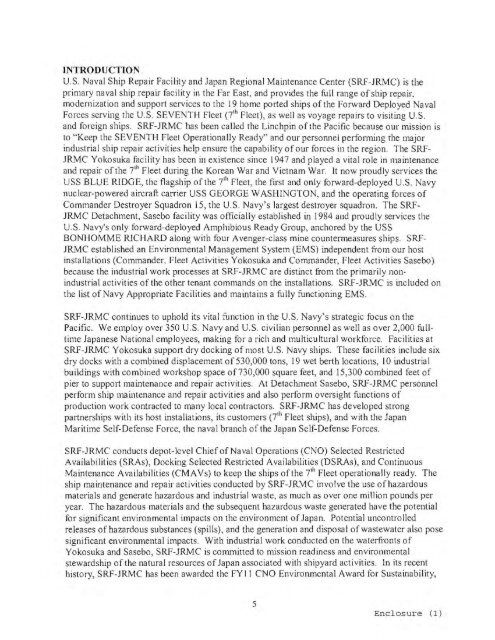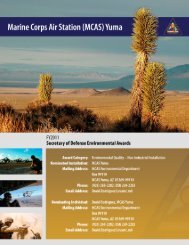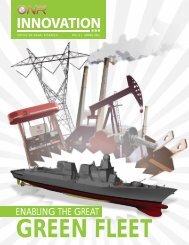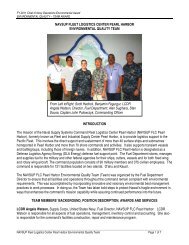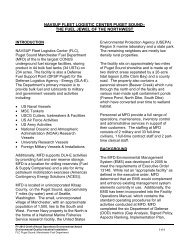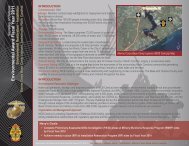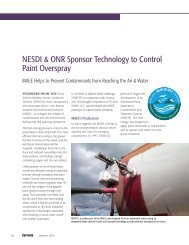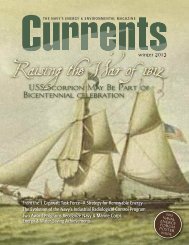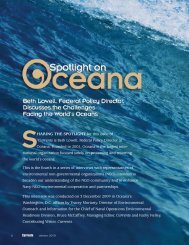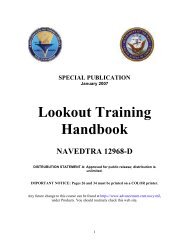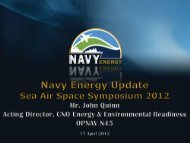U.S. Naval Ship Repair Facility and Japan Regional Maintenance ...
U.S. Naval Ship Repair Facility and Japan Regional Maintenance ...
U.S. Naval Ship Repair Facility and Japan Regional Maintenance ...
You also want an ePaper? Increase the reach of your titles
YUMPU automatically turns print PDFs into web optimized ePapers that Google loves.
INTRODUCTIONU.S. <strong>Naval</strong> <strong>Ship</strong> <strong>Repair</strong> <strong>Facility</strong> <strong>and</strong> <strong>Japan</strong> <strong>Regional</strong> <strong>Maintenance</strong> Center (SRF-JRMC) is tbeprimary naval ship repair facility ill the Far East, <strong>and</strong> provides the full range of ship repair,modernization <strong>and</strong> support services to the 19 home ported ships of the Forward Deployed <strong>Naval</strong>Forces servulg the U.S. SEVENTH Fleet (7'h Fleet), as well as voyage repairs to visitUlg U.S .<strong>and</strong> foreign ships. SRF-JRMC has been called the Linchpin of the Pacific because our mission isto "Keep the SEVENTH Fleet Operationally Ready" <strong>and</strong> our personnel performing the majorindustrial ship repair activities help ensure the capability of our forces in the region. The SRFJRMC Yoko suka facility has been U1 existence since 1947 <strong>and</strong> played a vital role in maintenance<strong>and</strong> repair of the 7'h Fleet during the Korean War <strong>and</strong> Vietnam War. It now proudly services theUSS BLUE RJDGE, the flagship of the 7'h Fleet, the first <strong>and</strong> only forward-deployed U.S. Navynuclear-powered aircraft carrier USS GEORGE WASHINGTON, <strong>and</strong> the operating forces ofComm<strong>and</strong>er Destroyer Squadron 15, the U.S . Navy's largest destroyer squadron. The SRFJRMC Detachment, Sasebo facility was officially established in 1984 <strong>and</strong> proudly services theU.S. Navy's only forward-deployed Amphibious Ready Group, anchored by the USSBONHOMME RJCHARD along with four Avenger-class mine countermeasures ships. SRFJRMC established an Environmental Management System (EMS) independent from our hostinstallations (Comm<strong>and</strong>er, Fleet Activities Yokosuka <strong>and</strong> Conun<strong>and</strong>er, Fleet Activities Sasebo)because the industrial work processes at SRF-JRMC are distu1ct f)'om the primarily nonindustrialactivities of the other tenant comm<strong>and</strong>s on the installations. SRF-JRMC is included onthe list of Navy Appropriate Facilities <strong>and</strong> maintains a fully functioning EMS.SRF-JRMC continues to uphold its vital function in the U.S. Navy's strategic focus on thePacific. We employ over 350 U.S. Navy <strong>and</strong> U.S. civilian personnel as well as over 2,000 fulltime<strong>Japan</strong>ese National employees, making for a rich <strong>and</strong> multicultural workforce. Facilities atSRF-JRMC Yokosuka support dry docking of most U.S. Navy ships. These facilities include sixdry docks with a combined displacement of 530,000 tons, 19 wet berth locations, 10 industrialbuildings with combined workshop space of730,000 square feet, <strong>and</strong> 15,300 combined feet ofpier to SUppOlt maintenance <strong>and</strong> repair activities. At Detachment Sasebo, SRF-JRMC personnelperform ship maintenance <strong>and</strong> repair activities <strong>and</strong> also perform oversight functions ofproduction work contracted to many local contractors. SRF-JRMC has developed slrongpartnerships with its host installations, its customers (7 'h Fleet ships), <strong>and</strong> with the <strong>Japan</strong>Maritime Self-Defense Force, the naval branch of the <strong>Japan</strong> Self-Defense Forces.SRF-JRMC conducts depot-level Chief of <strong>Naval</strong> Operations (CNO) Selected RestrictedAvailabilities (SRAs), Docking Selected Restricted Availabilities (DSRAs), <strong>and</strong> Continuous<strong>Maintenance</strong> Availabilities (CMAVs) to keep the ships of the 7'h Fleet operationally ready. Theship maintenance <strong>and</strong> repau' activities conducted by SRF-JR..'vIC involve the use of haza rdousmaterials <strong>and</strong> generate hazardous <strong>and</strong> industrial waste, as much as over one million pounds peryear. The hazardous materials <strong>and</strong> the subsequent ha zardous waste generated have the potentialfor significant environmental impacts on the environment of <strong>Japan</strong>. Potential uncontrolledreleases of hazardous substances (spills), <strong>and</strong> the generation <strong>and</strong> disposal of wastewater also posesignificant environmental impacts. With industrial work conducted on the waterfi'onts ofYokosuka <strong>and</strong> Sasebo, SRF-JRMC is conunitted to mission readiness <strong>and</strong> environmentalstewardship of the natural resources of <strong>Japan</strong> associated with shipyard activities. In its recenthistory, SRF-JRMC has been awarded the FYII CNO EnvirolUnental Award for Sustainability,5Enclosure (1)
Industrial Installation; the 20 II Secretary of the Navy (SECNAV) Safety Excellence Award formid-sized Industrial Activities Category for OCONUS <strong>and</strong> CONUS; the 20 II CNO Shore SafetyAward for OCONUS Industrial Category; <strong>and</strong> SECNAV Voluntary Protection Program (VPPJStar Site Recognition for both SRF-JRMC Yokosuka <strong>and</strong> Detachment Sasebo.BACKGROUNDThe date, IIMAR II , marked a watershed event in the histo ry of <strong>Japan</strong> <strong>and</strong> the U.S.-<strong>Japan</strong>alliance. The T6hoku 9.0 magnitude earthquake, subsequent tsunami, <strong>and</strong> the resultingFukushima nuclear crisis brought together Team SRF-JRMC (U.S. Navy, U.S. civilian, <strong>and</strong><strong>Japan</strong>ese National employees) to participate in Opercllion Tomodachi (Operation Friendship).Strict energy conservation measures in support of all of the people of <strong>Japan</strong> were implemented atthe SRF-JRMC Comm<strong>and</strong>. The badly damaged Fukushima nuclear plant released a radioactiveplume that contaminated air <strong>and</strong> water. In the aftermath of the Fukushima nuclear power plantrelease, radiation precautions were taken for 7th Fleet ships to leave port after rad ioactiveparticulate fallout fi'o m Fukushima was detected in Yokosuka. Team SRF-JRMC conducted anSRA-at-Sea fo r the USS GEORGE WASHINGTON (CVN-73), an SRA at Detachment Sasebofor the USS LASSEN (DDG-82), <strong>and</strong> the Port Visit (PVST) at Yokosuka for the USS CURTISWILBUR (DDG-54) during the uncertain <strong>and</strong> challenging period in 20 I I. Durulg the SRA-atSea, there was zero enviroJUnental or safety violations or mishaps .. The unprecedented SRA-atSea assured sustained readiness for the 7 ,10 Fleet in its mission in the Pacific.In the face of the continuing cha llenges due to IIMARII, the dedicated SRF-JRMC Teamsustains a robust environmental management program that is in full conformance with theIntel11ational Orga nization of St<strong>and</strong>ards (ISO) 1400 I EM S requirements. Environmentalpersonnel co mprised of both U.S. civilian <strong>and</strong> <strong>Japan</strong>ese National employees at SRF-JRMCYokosuka <strong>and</strong> Detachment Sasebo help to implement the EMS <strong>and</strong> enviroJUnental mediaprograms to ensure compliance with the <strong>Japan</strong> Environmental Govel11ing St<strong>and</strong>ards <strong>and</strong> NavydU·ectives. The SRF-JRMC EMS is the model for the region. SRF-JRMC promotes EMSresource-sharing <strong>and</strong> training, to include host installations <strong>and</strong> other activities, in the EMS PlanDo-Check-Act execution. In August 20 12, SRF-JRMC hosted <strong>Naval</strong> Civil Engineer CorpsOfficers School (CECOS) sponsored training on Integrated EMS <strong>and</strong> Compliance Auditing <strong>and</strong>persormel fi'om other EMS-Appropriate facilities were invited, <strong>and</strong> attended the training.Tlu'ough these efforts, other activities throughout the Far East have implemented the EMSquality management system approach created at SRF-JRMC. Another resource-sharing effort isthat SRF-JRMC leveraged our EMS to implement the Voluntary Protection Program (VPP),which is structured on the contents of Occupational Hea lth & Safety St<strong>and</strong>ard (OHSAS) 1800 1.SRF-JRMC was successfully recognized with VPP Star Site Recognition in Feb 2012, becomingthe first Navy activity outside of the U.S to achieve this status.ACCOMPLISHMENTSEnvironmental Management System Conformance <strong>and</strong> Noteworthy PracticesSRF-JRMC ha s implemented an EMS in full conformance with ISO 14001 <strong>and</strong> OPNAVINST5090.1 C. In May 2009, an external EMS audit team fro m NAVSEA found zero nonconformancefindings during the first audit upon implementation of the EMS at SRF-JRMC. InApril 2012, <strong>Naval</strong> Facilities Engineering Comm<strong>and</strong> (NA VFAC) Pacific conducted the secondexternal EMS extel11al a.udit for SRF-JRMC <strong>and</strong> for the second consecutive audit, the team foulld6Enclosure (1)
zero non-conformance fmdings. The NAVFAC Pacific auditors cited three NoteworthyPractices at SRF-JRMC: the development of st<strong>and</strong>ard operating procedures (SOPs) to insurecontinuity <strong>and</strong> consistency in the administering <strong>and</strong> managing of environmental med ia pro grams;implementing the "Energy Conservation PasspOlt" described in a later section; <strong>and</strong> our proactivestance in providing environmental awareness briefings to sbipboard persormel. The outst<strong>and</strong>ingrecord of zero non-conformance findings in two consecutive external audits may be attributed tothorough application of the fundamental requirements of ISO 14001: top managementengagement during EMS management reviews; an environmental quality management documentsystem inc luding procedures (such as SOPs) that are followed <strong>and</strong> implemented; an internal auditprocess that is caJTied out by Na vy-qualified EMS auditors; <strong>and</strong> regular communication <strong>and</strong>training programs on environmental topics. The EMS document system includes the EMSManual, <strong>and</strong> four types of SOPs: one type to implement the 18 I SO 14001 elements; a secondtype to implement environmental media programs; a third type to implement specific processmonitoring requirements conducted by production persolmel such as pH monitoring <strong>and</strong>underground storage tank leak monitoring; <strong>and</strong> a fourth type to implement an environmentalquality sampling program. The susta inment <strong>and</strong> continuous imp rovement of our outst<strong>and</strong>ingEMS has been supported by the SRF-JRMC Comm<strong>and</strong>ing Officer <strong>and</strong> all SRF-JRMC persormelin regards to the Comm<strong>and</strong>'s commitment to environmental compliance <strong>and</strong> continualimprovement. The following paragraphs provide more features of o ur EMS.Training <strong>and</strong> Communication Practices: The EMS has been useful for improving training atSRF-JRMC. A gap in training that rnvolved a lack of knowledge in hazardous material (HM)compatibility was identified in the hazard communication (HAZCOM) training program forSRF,JRMC personnel. To close the gap, the FY II EMS Team developed <strong>and</strong> provided trainingon HM incompatibility <strong>and</strong> storage to over 1,300 employees in production shops <strong>and</strong> supportcodes over a four month period. In FY 12, the HM incompatibility training was incorporated iNOthe annual HAZCOM training program to ensure the training is consistently provided to allproduction shops <strong>and</strong> appLicable support codes. SRF-JRMC has trained over 2,500 employeeson EMS awareness since the begilming of EMS program implementation in 2007. To maintain a100% complet ion rate for EMS awareness training, the environmental division established twotypes of training methods: web-based to capture employees with access to a work computer <strong>and</strong>Classroom training to capture employees without ready access to a workplace computer due tothe nature of their job. The use of two different train ing methods <strong>and</strong> incorporation of theenvironmental division in the training process ha s ensured that SRF-JRMC maintains a hightraining success rate. The training is provided in English or in <strong>Japan</strong>ese, as appropriate, for ouremplo yees. In FY II <strong>and</strong> FY 12, 220 new personnel completed EMS awareness training. Tocontinuously communicate <strong>and</strong> increase awareness of EMS <strong>and</strong> environmental related issues, theenviromnental offices at SRF-JRMC Yokosuka <strong>and</strong> Detachment Sasebo develop <strong>and</strong> distributemonthly environmental newsletters to all shops <strong>and</strong> codes. Additiona lly, the awareness effortsinclude proactively providing nil1e articles in FY II <strong>and</strong> FY 12 which were published in theYokosuka installation newspaper (Seahawk), as well as having the SRF-JRMC EnvironmentalPolicy Statement posted on bulletin boards throughout the comm<strong>and</strong>. To enhance the ability ofthe environmental staff to perform intemal audits <strong>and</strong> increase the quality of our audits, 14 out of20 personnel in the envirorunenta I offices at both Y okosuka <strong>and</strong> Detaclll1ent Sasebo havecompleted the Integrated EMS <strong>and</strong> Compliance Auditing training provided by CECOS.7Enclosure (1)
Additionally, while undergoiJ1g ship repair <strong>and</strong> maiJ1tenance at SRF-JRMC, the activities of theafloat forces (ship personnel) can have potentially significant impacts on the environment. Toengage this potential impact, SRF-JRMC ha s taken a leading role in being close partners withship's force. The comm<strong>and</strong> provides presentations to ship's force prior to ship availabilities toinform them of spill prevention, pollution prevention, waste disposal, <strong>and</strong> recycling inaccordance with U.S. Navy <strong>and</strong> local environmental st<strong>and</strong>ards, On a routine basis, SRF-JRMCenvironmental team members participate in environmental safety briefs before ship refueling <strong>and</strong>defueling evolutions, ensure proper spill prevention measures are in place, <strong>and</strong> providesurveillance of the harbor waters during these operations to prevent <strong>and</strong> respond to spills,Environmental personnel participated in over 120 environmental safety briefs in FY II <strong>and</strong> FY 12related to ship refueling <strong>and</strong> defueling evolutions.Cross-Functional Teams: SRF-JRMC establishes EMS Aspect Teams each year with teammembers drawn from a cross section of the shops <strong>and</strong> codes at SRF-JRMC related to the EMSAspect. This diversity in personnel helps bring new ideas <strong>and</strong> approaches <strong>and</strong> production shop,perspectives to improve environmental compliance <strong>and</strong> prevent pollution while keeping the 7"Fleet operationally ready. Team members have, for the past four years, successfully identified<strong>and</strong> documented SRF-JRMC significant aspects <strong>and</strong> impacts to the environment; establishedlong telm EMS Objectives <strong>and</strong> shol1 tern] EMS Targets for achieving environmental compliance<strong>and</strong> pollution prevention; <strong>and</strong> identified processes <strong>and</strong> resources needed to achieve measurableperformance goals. In FYII <strong>and</strong> FYI2, in addition to environmental office personnel, crossfunctionalteam members included personnel from the Service Shop Group, the Boiler/FittingShop Group, the Shop Division, <strong>and</strong> the Safety office.Management Review: Updates on EMS <strong>and</strong> envirolUllental compliance are presented to SRFJRMC top management at EMS Management Reviews on a qual1eriy basis, exceeding theminimum requirements ofOPNAYINST S090.1C. The quarterly reviews are attended by theSRF-JRMC Comm<strong>and</strong>ing Officer, department heads <strong>and</strong> production group masters <strong>and</strong> provide aregular forum for executive management to be informed about EMS activities, environmentaltrends, <strong>and</strong> events <strong>and</strong> projects targeted at improving our environmental performance. Thefrequency is helpful to keep compliance concerns in the spotlight <strong>and</strong> also allows timelydiscussions on current topics, An example of a timely discussion is the discussion that occUlTedduring a FY 12 second qualter EMS management review about an increasing trend that wasidentified for steam usage in the first quarter. The discussion led to a refocusing of the target forthe FYI2 Energy Usage significant aspect to include steam usage. The 2012 external EMS auditteam fj-om NAYFAC Pacific made a Positive Observation frnding: that the qualierlymanagement reviews with SRF-JRMC senior management demonstrates the commitment <strong>and</strong>engagement of senior management to successfully implement our EMS.The quality of our environmental program is further demonstrated by the fo llowingaspect/impact success stories,Waste Reduction <strong>and</strong> Waste Management.Recycling <strong>and</strong> Waste Reduction, The SRF-JRMC Comm<strong>and</strong>ing Officer's Environmental PolicyStatement promotes <strong>and</strong> requires everyone at SRF-JRMC to reduce, reuse <strong>and</strong> recycle resources,<strong>and</strong> to purchase recycled materials wherever feasible, SRF-JRMC is the largest contributor of8Enclosure (I)
scrap metal to the Yokosuka installation Qualified Recycling Program (QRP), <strong>and</strong> also regularlyrecycles paper, cardboard, batteries, used oil <strong>and</strong> empty containers. In addition, SRF-JRMC hasworked closely with the personnel of the QRP office to proactively support the solidwaste/recycling program. SRF-JRMC took the initiative to plan <strong>and</strong> execute solid wasterecycling events in FY II <strong>and</strong> FY 12 <strong>and</strong> coordinated with the QRP office to support the events.The first Recycle Day event conducted in FY II resulted in the successful collection of over8,000 pounds of recyclable material from SRF-JRMC shops <strong>and</strong> codes tumed over to the QRP.This successful diversion of items that could have entered the solid waste stream was exceededthe fo !lowing year. ln FY 12, over 13,000 pounds of recyclable material was collected, includingfurniture, metal cabinets, old equipment, <strong>and</strong> even old bicycles. ln addition to the recyclingaspect, the recycling events were used to increase awareness of proper waste disposal procedures<strong>and</strong> to prevent improper disposal of waste. Pre-event screening by environmental personnel ofmaterial scheduled to be tumed in was conducted, <strong>and</strong> h<strong>and</strong>outs were distributed to all shops <strong>and</strong>codes pmiicipating in the events. The frequency of improper waste disposal fmdings such asrecyclable metal material ab<strong>and</strong>oned near general trash dumpsters has shown year to yeardecreases, with the largest reduction coming in FY II (63% reduction compared to the baseline 'ofFY09).Improved Wastewater Management. SRF-JRMC Yokosuka owns <strong>and</strong> operates its own industrialwastewater treatment facilities, which can remove heavy metal contaminants <strong>and</strong> suspendedsolids Ii-om wastewater. Bilge oily wastewater, compensating water <strong>and</strong> tank cleaning watergenerated during ship repair <strong>and</strong> maintenance work is treated at our SRF-JRMC intermediatetreatment facility, <strong>and</strong> the treated wastewater is then sent to a NAYFAC sewage treatmentfacility for fmal treatment. Improvements in the wastewater h<strong>and</strong>ling <strong>and</strong> treatment process havebeen the focus of an EMS Aspect Team fi'om FY I 0 through FY 12, <strong>and</strong> Objectives <strong>and</strong> Targetswere determined each year. Three projects related to these objectives <strong>and</strong> targets for reducingSRF-JRMC environmental impact from wastewater go beyond simplv meeting regulatoryrequirements:I) The FYII EMS Aspect Team, following up on effOlis fi'om FY I 0, established a target goal ofreducing the disposal cost ofreceived oily wastewater by 25% compared to FYIO. The Teamwas comprised of the operators of the treatment facility <strong>and</strong> enviromnental persolmel. Theefforts of the FYIO EMS Aspect Team had led to an underst<strong>and</strong>ing that high levels of suspendedsolids (SS) was the primary factor detennining the su itability of treating the oily wastewater, thatis, high levels of SS made the wastewater unsuited for the treatment facility <strong>and</strong> led to untreatedwastewater having to be contracted out for disposal. The Team,. with the cooperation of theproject management team assigned to a ship repair project, proceeded to "pre-treat" 10,000gallons of wastewater with high levels of SS using a pre-treatment filtering system provided by alocally contracted <strong>Japan</strong>ese company. This effort resulted in diverting much of the high SSwastewater back to the treatment facility <strong>and</strong> an estimated 80% reduction in the volume ofwastewater that was contracted out for disposal without treatment. Subsequently, tile Team usedthe "super filter" in conjunction with the SRF-JRMC bilge <strong>and</strong> oily wastewater treatment system(BOWTS) to treat wastewater from five additional ship repair projects. The improvements fromthese activities ulc1uded increased utilization of the treatment facility, the associated reduction inthe volume <strong>and</strong> cost of disposed wastewater, <strong>and</strong> faster removal of wastewater from its storagebarge. The Team's effOlis resulted in "reclaiming" an estimated 42,000 gallons of wastewater9Enclosure (1)
that would otherwise have been sent to a contractor for disposal, saved i.n excess of an estimated$140,000 i.n avoided waste disposal cost <strong>and</strong> which meant i.ncreased dollars for the mai.ntenanceof 7th Fleet ships, <strong>and</strong> a 26% reduction in disposal cost for the year.2) SRF-JRMC initiated an "Advanced Biological Process" pilot project to demonstrate the use of"dissolved oxygen augmentation" through a partnership with NAVSEA <strong>and</strong> <strong>Naval</strong> SurfaceWarfare Center Carderock Division. The environmental office obtained over $100,000 from theQRP fund for the project, <strong>and</strong> staged the project equipment at our facility. The project goal wasto utilize technology to degrade hydrocarbon compounds i.n oily wastewater generated duringship repair operations, <strong>and</strong> it was carried out in Oct <strong>and</strong> Nov 2010. The pilot test results showedthat four regulated contaminants (biological oxygen dem<strong>and</strong>, total suspended soJids, mineral oil,<strong>and</strong> animal <strong>and</strong> vegetable fat) were reduced greater than 90% by the process, <strong>and</strong> chemicaloxygen dem<strong>and</strong> was reduced by 75%. The project also greatly enhanced the knowledge <strong>and</strong> skillset of our wastewater program managers <strong>and</strong> production shop BOWTS operators, <strong>and</strong> provided aworki.ng level view of an altemative treatment process for oily wastewater. It also resulted in acost avoidance of approximately $11,000., as the wastewater was treated prior to the use of the"super filter" <strong>and</strong> was judged to be the type with high levels of suspended so lid s that would havebeen disposed of by a contractor instead of being treated by the BOWTS.3) In FY II, the EMS Aspect Team partnered with NAVFAC Hawaii <strong>and</strong> learned about bestpractices for wastewater treatment of bilge <strong>and</strong> oily wastewater as well as of i.ndustrial processwastewater. In FY 12, the Team followed up by performing i.nitial testing on two types ofindustrial process wastewater to determine the feasibility of increasing the types of wastewatertreated in-house by SRF-JRMC. For dyed chill water removed fi-om ship systems as wastewater,laboratory analyses <strong>and</strong> jar tests were perfonned by a local contractor <strong>and</strong> the results indicatedthat with the proper use of readily available material <strong>and</strong> the facilities on h<strong>and</strong> at SRF-.IRMC,this type of wastewater can be treated i.n house. A second type of wastewater generated duringsurface preparation ofa ship's exterior hull was also evaluated <strong>and</strong> shown to be suitable fortreatment by the BOWTS facility. Prelimi.nary case analyses have been completed for thetreatment of these wastewaters, <strong>and</strong> more complete analyses will be performed to allow SRFJRMC to decide if it makes environmental, economic <strong>and</strong> social sense to treat them in house orcontinue to tum them over to contractors.Energy Conservation. Energy use is another aspect that SRF-JRMC has sought to improve viaEMS Aspect Teams. At the start of FY II, the EMS Energy Use Team at Yokosuka targetedactivities that would help achieve e lectricity use reduction tlrroughout the comm<strong>and</strong>: replacementof energy intensive mercury lamps with LED lamps; i.nefficient c lothes dryer replacement, <strong>and</strong>personnel energy conservation actions. By the end of the tiscal year, SRF-JRMC had exceededthe Goverrunent of <strong>Japan</strong>'s m<strong>and</strong>ated electricity use reduction target of 15% for large industrialusers i.n Eastem <strong>Japan</strong> by reduci.ng electricity consumption by 24% for all of FY II compared toFYJO. The Goverrunent's 15% reduction target was established after J IMARJ J <strong>and</strong> theFukushima nuclear crisis, <strong>and</strong> the EMS Team <strong>and</strong> SRF-.TRMC personnel exp<strong>and</strong>ed energyconservation efforts i.n response for the remai.nder of FY II <strong>and</strong> conti.nued i.nto FY J 2. In FY 12,SRF-JRMC Yokosuka <strong>and</strong> Detachment Sasebo carried out an "Energy Conservation Passport"(ECP) campaign leadi.ng up to <strong>and</strong> conti.nui.ng throughout the summer of2012. The campaignwas modeled after the successful VPP Passport campaign, <strong>and</strong> consisted of a pri.nted, bilingual10Enclosure (1)
Passpoli h<strong>and</strong>book composed of 15 items related to energy conservation, at least 10 ofwhichneeded to be completed by personnel. The ECP supported the overall goal of the SRF-JRMCEMS, <strong>and</strong> SECNAV <strong>and</strong> Department of Defense energy policy. In addition, the energyconservation activities also suppOlied the saving of electricity in Sasebo in response to forecastedshortages of electricity supply in the summer of 20[2. Of the approximately 2,800 personnel atSRF-JRMC, 91% (89% at Yokosuka <strong>and</strong> 100% at Detaclunent Sasebo) completed the ECP. Anillustration of the interest ofSRF-JRMC persolU1el in energy conservation is the fact that oneECP item, which was voluntary, asked persormel to provide an idea to promote further energysavings in SRF-JRMC. More than 600 persormel completed this item <strong>and</strong> the variety ofsuggestions included proven <strong>and</strong> also sensible ideas (e.g., changing to LED bulbs, greenpromotion, using motion sensors, reducing the use of vending machines, promoting bicycle use).At Detachment Sasebo, more energy efficient lighting was installed in a shop area <strong>and</strong> thecalibration laboratory during FY 12 utilizing QRP funding. [n Yokosuka, another energy savingsuggestion, use of solar panels, will be implemented in FYl3 to power outdoor lighting at ourmain building. SRF-JRMC also actively partners with the Energy Programs on both CFA Y <strong>and</strong>CFAS. The Building Energy Manager program is in place <strong>and</strong> operational at SRF-JRMCYokosuka <strong>and</strong> Detaclullent Sasebo. Environmental personnel in Yokosuka have provided withinthe past two years valuable facility-related data to the energy program, such as the number ofbuilding emergency exits signs <strong>and</strong> the number of shower heads, that has been used in NAVFACfunded energy projects.Community Involvement in <strong>Japan</strong>SRF-JRMC personnel are involved with the conununities around Yokosuka <strong>and</strong> Sasebo invarious ways, such as regular volunteer visits to a home for the mentally challenged <strong>and</strong>donations to charity. SRF-JRMC personnel also have contributed to our conununities inenvironmental-related ways. One environmental office persOlUlel participated in a projectsponsored by Zushi City, near Yokosuka, in 2012, <strong>and</strong> along with local conununity residents <strong>and</strong>other U.S. personnel, picked up trash for a river cleanup. Two other environmental officepersonnel have made a total of six trips to the Tohoku area of <strong>Japan</strong> that was severely impactedby the ealihquake <strong>and</strong> tsunami of2011. The main purpose of the trips was to assist in therecovery <strong>and</strong> rebuilding efforts in various Tohoku communities. Both perso nnel assisted throughvolunteer groups helping with recovery efforts such as the removal of mud <strong>and</strong> debris that hadfull y clogged community stonn water drain systems, a condition which led to rain water floodingstreets <strong>and</strong> intruding into yards <strong>and</strong> other areas. One of the personnel also participated in arecycling research project in Fukushima prefecture, the area affected by the nuclear power plant.In these ways, SRF-JRMC personnel are helping to support our conununities in <strong>Japan</strong>.Continual Improvement <strong>and</strong> Environmental QualitySRF-JRMC is committed to the sustainability of the environment through environmentalcompliance as well as sustainability of the SRF-JRMC mission by mitigating environmentalvulnerabilities. Our goal is to effectively conUllunicate our strong envirolUllental commitment<strong>and</strong> promote environmental awareness <strong>and</strong> stewardship. Our EMS allows us to realize continualimprovement in environmental quality through the combined efforts of all of our persOlUlel <strong>and</strong>stakeholders. These efforts have suppolied sustainment <strong>and</strong> strengthening of the U.S. - <strong>Japan</strong>Alliance. SRF-JRMC Team members are stewards of the environment for the next generation.As the SRF-JRMC motto goes, Nail Demo Dekimasu - We Can Do Anything!11Enc l osure (1)


